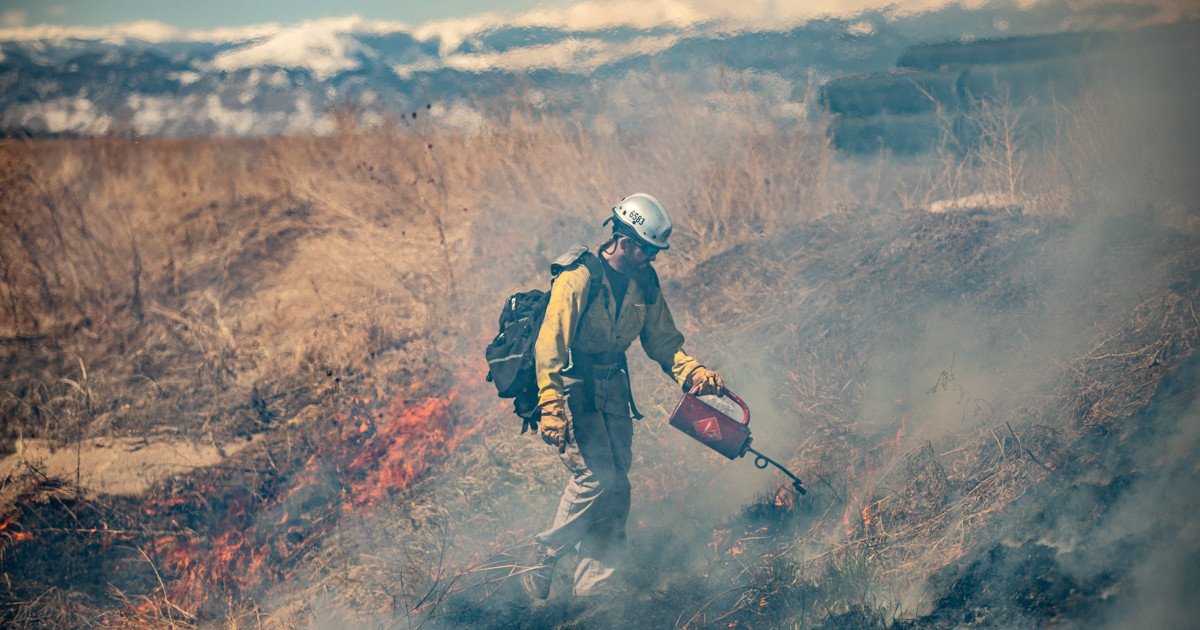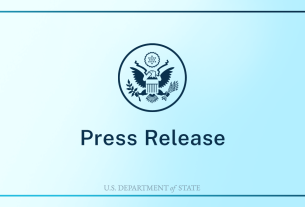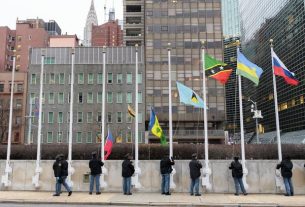ProPublica is a nonprofit newsroom that investigates abuses of power. Sign up for Dispatches, a newsletter that spotlights wrongdoing around the country, to receive our stories in your inbox every week. This story was co-published with COLab, the Colorado News Collaborative.
Colorado’s snowcapped Rockies towered in the distance on a crisp April day as firefighter Emilio Palestro used a torch to ignite damp prairie grass within view of a nearby farmhouse and a suburban neighborhood.
Propelled by a breeze, orange flames crackled up a ditch bank, devouring a thick mat of dead grass, cornhusks and weeds. It was neither too windy, nor too humid, nor too hot — a rare goldilocks moment for firefighters to safely clear irrigation ditches of weeds, grasses and brush that can block the flow of water and spread wildfire.
“At this time of year, it’s a race against what we call green-up,” said Seth McKinney, fire management officer for the Boulder County Sheriff’s Office, as eye-stinging smoke curled over newly emerging shoots of grass nourished by a wet winter. “We are threading that needle to find the right time in between a rainstorm, red flag conditions” — when winds, temperatures and dry conditions magnify wildfire risk — “and snow melt.”
McKinney is trying to prevent conflagrations like the Marshall Fire, the most destructive wildfire in the state’s history, which killed two people and incinerated 1,084 residences and seven businesses in December 2021. That fire ignited in overgrown grasslands crisscrossed by unkempt ditches, which together spread flames into urban areas with unprecedented speed, according to scientific simulations and eyewitnesses.
Credit:
Sangosti/MediaNews Group/The Denver Post via Getty Images

Credit:
Chet Strange
The controlled use of fire by expert crews is widely considered the most effective way to reduce the dangerous build-up of grasses and other vegetation that fuel larger conflagrations, experts agree.
But it has become nearly impossible to conduct controlled burns like the one McKinney’s crew set last month. A combination of overly broad restrictions, erratic weather patterns and public resistance have left piles of dead branches and shrubs sitting in open spaces for months.
Figuring out how to overcome these barriers, prevalent throughout the West, is crucial to addressing the fire risk, say land managers whose homes were also threatened by the Marshall Fire.
“We’ve done a lot of work in the forests about what to do to reduce fire risk and anticipate fire behavior,” said Katharine Suding, a plant community ecologist at the University of Colorado Boulder who is working to update fire modeling of prairie vegetation. “We need to do that in the grasslands.”
The restrictions and a burdensome planning process often postpone or indefinitely delay controlled burns. Firefighters must complete multipart plans and comply with rules that can differ in each of Colorado’s 64 counties. Large burns on federal, state or county land require permits from the Colorado Department of Public Health and Environment to ensure they don’t violate federal clean-air regulations. And in some areas, burns are off-limits from November through February because air pollution is already high.
The end result is that only a small fraction of what needs to be burned ends up being burned. In 2020, firefighters proposed burning 312,943 piles of branches and logsthroughout the state but were able to do only about 18% of that work,records show. Of 88 burns proposed to consume vegetation across a large number of acres — in a forest or grassy area — only 55% were completed that year.

Credit:
Chet Strange, special to ProPublica
Extreme weather and climate change also are getting in the way of executing prescribed burns, documents obtained by ProPublica under the Colorado Open Records Act show. In 2022, a prescribed fire driven by high winds and tinder-dry vegetation morphed into the largest fire in New Mexico’s history, with devastating consequences for residents.
In Colorado, residents grew wary of controlled burns after one escaped in 2012 and killed three people. The Lower North Fork Fire, near the foothill community of Conifer, burned 24 structures and 4,140 acres. Afterward, prescribed burning ceased as state lawmakers enacted stricter rules governing the practice.
Only about 1 in 1,000 prescribed burns spirals out of control, statistics show, but the ones that do have added to public opposition.
The push-pull of fire prevention and community opposition could soon come to a head as the U.S. Forest Service, Western governors and Colorado counties ramp up prescribed burning to rid overgrown forests and open spaces of a century worth of fuel, aiming to better protect nearby communities. Federal fire simulations found 500,000 buildings could now be exposed to wildfire in a single year.
Public lands managers hope to treat 50 million acres with controlled burns and mechanical thinning in the next decade.
After Larry Donner, a retired fire chief in Boulder, and his wife purchased their house in 1991, they installed noncombustible siding, double-paned windows and a fire-resistant roof, and they replaced a wood deck with flagstone. Still, it burned to the ground in the Marshall Fire. He attributed the fire’s spread to poor maintenance of open spaces near communities.
“Thirty years ago, they mowed 20 feet around subdivisions, or they grazed and plowed grasslands — then they planted houses and they stopped,” said Donner, who gestured toward grassy Davidson Mesa as he stood in front of his partially reconstructed Louisville home. “Fuel reduction is a big thing for me. If you can keep fire out of neighborhoods, you can better protect those neighborhoods.”


Credit:
Chet Strange, special to ProPublica
A New Understanding of Grassland Risk
Coloradans have always understood the threat of forest fires. The state ranks first among eight Western states for the number of acres at high risk for fire, or “firesheds,” federal models show.
The Marshall Fire, however, made many residents realize that the state’s vast and populous grasslands — abutting its largest metro areas on the eastern flank of the Rocky Mountains — are also a wildfire threat. Cities from Fort Collins, in the north, to Pueblo, in the south, where most Coloradans live, are surrounded by thousands of square miles of flat, open space that evolved to burn every five to 15 years.
The fireshed around Boulder and the Arvada fireshed to the south are among the 10 most at-risk zones from Wyoming to Nebraska, according to the U.S. Forest Service. Boulder ranked 41st in the western U.S. out of 7,688 such hazardous areas.
Around the Denver metro area, grassland acres outnumber forest acres, according to a first-of-its-kind analysis conducted for ProPublica using wildland fire data compiled by federal agencies.
This spring, wildfires in grasslands and brush on the eastern slope of the Rockies, known as the Front Range, have already forced evacuations and concert cancellations in suburban enclaves.
“The urgency of fire in the county, whether in the mountains or on the plains, is very real,” said Boulder County Commissioner Ashley Stolzmann during a February meeting.
In the forests that blanket Boulder County’s foothills, residents are accustomed to smoke in the air. Firefighters have burned vegetation there, primarily in the woods, since 1997. But for every successful burn, there are just as many that don’t happen, public records obtained by ProPublica show.
Each year, the Boulder County wildland team and the city of Boulder’s Fire-Rescue unit request smoke permits — required when burns on public lands could cause air quality issues — from the Colorado Department of Public Health and Environment’s Air Pollution Control Division. Many are for county- and city-managed open spaces. Some foothill areas are grassy, like the valley floor below.
The permits require contingency plans, notification of nearby residents and analysis of the vegetation, and are approved only when winds are deemed less likely to send smoke toward homes.
Burns aren’t allowed when the state issues air pollution emergencies or alerts for the area. And the number of high-ozone days along the northern Front Range and in the Denver metro area is increasing. The region is out of compliance with national air quality standards.

Credit:
Chet Strange, special to ProPublica
Brian Anacker, senior manager of science and climate resilience for the city of Boulder, said his community is “trying to accelerate our prescribed fire program.” But there are “barriers upon barriers” that stop that from happening.
Regulations can also work at cross purposes: Winter weather often offers the lowest risk of a prescribed burn getting out of control, but that’s also when smoke below 6,400 feet can most affect the region’s poor air quality.
Firefighters and state air quality regulators have begun experimenting with allowing burns in the metro Denver area during winter months.
“We are starting to look for more and more of what we would consider off windows,” said Brian Oliver, wildland fire division chief for the city of Boulder.
For example, Boulder County firefighters asked to burn up to 40 acres on Hall Ranch during snow season using “additional experimental provisions.” These included burning between 10 a.m. and 4 p.m. on days when the air is clear, discussing the timing with the state meteorologist and advising state air pollution staff at least a day in advance.
Firefighter David Buchanan last year asked regulators for permission to burn during the “high-pollution season,” when it’s typically prohibited. He said that granting the permit would allow crews to torch grassy areas and saplings when temperatures are low and there is more moisture on the ground. Doing so would minimize smoke, he added, because fuels burn “swiftly and efficiently.” State regulators granted the permit.
Boulder County’s challenges were echoed by federal watchdogs and Western governors. The Government Accountability Office and state leaders this spring urged the Environmental Protection Agency to reconsider regulations that curtail prescribed burning in areas that aren’t in compliance with air quality standards.
Land managers told the GAO that these rules “could limit their ability” to rid high-risk areas of vegetation, investigators said in a March report. The GAO added that controlled fires could lead to less smoke overall because they help prevent future wildfires.
Both the rising interest in controlled burns and the difficulty in conducting them are apparent at the state’s Division of Fire Prevention & Control. The agency, created after the escaped Lower North Fork Fire, requires firefighters to complete a “prescription” that assesses 23 risk factors, including how quickly fuels will burn, how likely the fire is to escape, how smoke can be managed and how far the fire is from homes and businesses.
Ensuring the public understands that there’s a detailed, scientific process behind prescribed burning is key to gaining support for more controlled burns, firefighters and land managers agree.
Also included in the prescription are optimal weather conditions, including a minimum temperature for burns in grass and brush of 30 degrees and a maximum of 80 degrees; relative humidity between 5% and 40%; and wind speed between 2 mph and 15 mph.
Such conditions are becoming rarer.
Snowstorms, fire weather watches and red flag warnings — alerts sent out when dry air and high, gusty winds create conditions that could rapidly spread fires — forestalled prescribed burns this spring in the city of Boulder. Burning is prohibited when these warnings, issued by the National Weather Service, are in effect.
Sometimes, all the conditions align: The Forest Service said in May it was able to burn approximately 25,000 piles of dead vegetation this winter across the Arapaho and Roosevelt national forests. The federal agency, along with other partners, also intentionally burned more than 110 acres in this region this spring.
Grassland Wildfire Risk Foreshadowed in 2009
Residents on the valley floor in Boulder County remain leery of controlled burns, and many are also angry at what they view as a lack of urgency to address the fire threat surrounding dense suburbs.
“Our neighborhood is like a ship at sea in grasslands,” Collen Callin, a Superior resident whose home survived the Marshall Fire, said following a March community forum attended by Gov. Jared Polis and U.S. Rep. Joe Neguse, both Democrats.
“If they don’t mitigate them, I’m to the point that I get so stressed with winds I will probably leave,” added Callin, who handed Neguse a flier that detailed how the blaze climbed from grasslands onto wood fences that “created firebrands that were blown into our yards and caught homes on fire.”

Credit:
Chet Strange, special to ProPublica
Land managers are urging patience. Officials are updating Community Wildfire Protection Plans to weigh options for managing the fuels but warn the process will take a year to complete.
The last plan was made 12 years ago and acknowledged wildfire risk isn’t limited to mountainous communities. “Plains residents are also at risk,” authors wrote, citing lessons from the 2009 Olde Stage Fire.
In hindsight, that blaze was eerily similar to the Marshall Fire — severe winds and “large evacuations of residents and their animals just after the holiday season.” But unlike the Marshall Fire, it slowed as the winds died down, allowing firefighters to control it before it burned homes.
Still, it prompted planners to identify a “grassland wildland-urban interface,” though they didn’t offer ideas to address the risk to communities on the plains.
The plan that’s being developed will have to address this issue, but the reality is the options are few — mow, graze or burn — and none are easy to carry out or guaranteed to be effective.
“We have 343 miles of agricultural property boundaries we manage,” said Stefan Reinold, resource management division manager for Boulder County Parks and Open Space. “Are we going to mow a 100-foot buffer twice a year? Is that really going to stop a fire — or are embers going to make it into neighborhoods?”

Credit:
Chet Strange, special to ProPublica
Millions of dollars in state and federal grants are available for mitigation work on open-space grasslands. At the March community forum in Superior, state officials were asked if they would consider legislation to aid communities in deciding which methods are the most effective. Lawmakers said they will discuss their approach this summer.
Firefighters would like prescribed burns to be part of the plan.
“Prescribed fire is the best way to keep grasslands healthy and vibrant,” Meg Halford, senior forest health planner for Boulder County, said at a Jan. 30 town hall. “What is scary is that we would do it behind your communities — not that it can’t be controlled.”
One day this spring, Buchanan, the Boulder County firefighter who’d requested out-of-season burn permits, slapped out errant wisps of flame on a ditch bank with a “mud flap on a stick.” The oddball device worked well to mop up the burn as Sheriff’s Office fire manager McKinney described how he hopes to tamp down the stigma that surrounds prescribed fire.
His team would like to increase agricultural burning, which is exempt from federal smoke management regulations. Doing more ditch burns would get residents more accustomed to the sight of intentionally set flames and smoke, McKinney said.
“The goal is to normalize it so people can see the conditions are good,” he said. “And they know we’ve had moisture recently and the winds aren’t high, so we must be lighting it for a reason.”

Credit:
Chet Strange, special to ProPublica
Do You Have a Tip for ProPublica? Help Us Do Journalism.
Got a story we should hear? Are you down to be a background source on a story about your community, your schools or your workplace? Get in touch.



